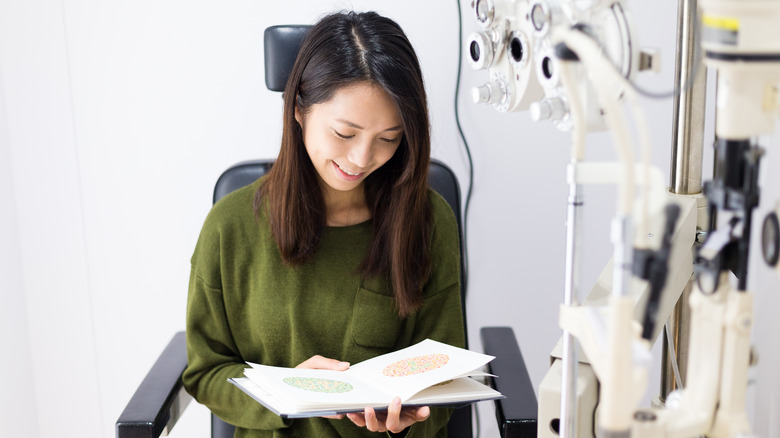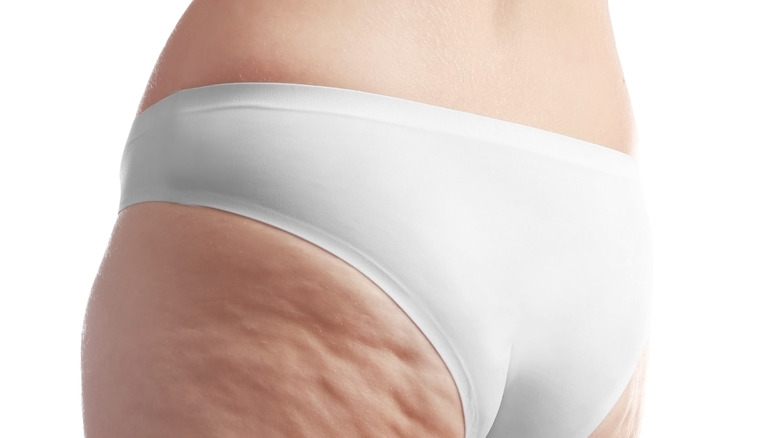Things People Don't Understand About The Female Body
Men are from Mars, women are from Venus — or at least that's what John Gray wrote in his book of the same name back in the early '90s. While some agree — and others disagree — with the aphorism, scientists have gone on to study the biological differences between men and women.
Peggy Drexler, a research psychologist and assistant professor of psychology at Weill Medical College, Cornell University, spent much of her career analyzing differences and similarities in the sexes. Surprise: we're all Earthlings. And, with that, we all have feelings, needs that must be met and so on. However, Drexler found that men and women do generally differ in how they express emotions, resolve conflicts, communicate, and experience regret.
Researchers have also discovered that male and female bodies have some pretty unique characteristics — many of which they are still trying to understand. Here are some things you may not have realized about the female body.
The "fast and strong" female immune system
Have you ever wondered why it is that a mom can come down with a cold and still manage to drop the kids off at school, go to work, and make dinner while her husband can catch the very same bug and is laid out for days? This phenomenon has been dubbed the "man flu." When hilarious mom of three and "That's Inappropriate" YouTuber Meredith Masony poked fun at "the man cold vs. the mom cold" in one of her videos, even men chimed in with comments like "spot on" and "100% accurate."
Marcus Altfeld, an immunologist at the Heinrich Pette Institute in Hamburg, Germany says women's bodies have "particularly fast and strong" immune systems — which might be why we don't get completely wiped out by the common cold. Unfortunately, our immune systems can also cause problems. In some people, immune systems overact and attack the body. Women are much more likely than men to develop autoimmune diseases and our powerful immune systems may just be the reason.
Hearing abilities
If you've ever accused a man of not listening to you, it's not totally his fault. He just isn't using both sides of his brain. No joke. According to research conducted at the Indiana University School of Medicine (via ScienceDaily), women use both sides of their brains to hear whereas men use just one.
But ladies, you shouldn't conclude that this makes you a better listener than your man. "Our research suggests language processing is different between men and women, but it doesn't necessarily mean performance is going to be different," Joseph T. Lurito, assistant professor of radiology at IU School of Medicine told ScienceDaily. "We don't know if the difference is because of the way we're raised, or if it's hard-wired in the brain."
There is a downside to this acute sense of hearing. One study discovered that women who suffer from stress-related exhaustion are hypersensitive to noise, which can cause even sounds that are produced a normal level to become painful for the hearer.
Pain threshold
For women to be able to give birth, they must have an incredibly high pain threshold, right? While there's no arguing the intensity of labor pains, the belief that women have a stronger tolerance to pain has been debated in a number of studies.
In one comprehensive study of 11,000 patients, researchers were able to "provide robust evidence that women report increased clinical pain compared to men across an array of diseases." Of course, this is a sample of reported pain. Could it be that women are more likely than men to admit they're in pain and thus seek treatment? One study explored the issue of gender roles and found that "while not unanimous, evidence suggests potential gender biases in pain treatment."
While science still seems to indicate that men have a higher pain threshold, this is definitely an area that many people — even doctors — don't fully understand about the female body.
Sense of smell
We're not sure if you know this, but your nose is pretty freakin' cool. In both men and women, smell receptors inside the nose send signals up through something called the olfactory nerve to the olfactory bulb. That precious bulb then tells the brain what it is you're sniffing. While the average man has a little over nine million cells in his olfactory bulb, women have a whopping 16 million. Women also have double the amount of neurons — brain cells that help you interpret information — than do men.
One study even demonstrated that women can improve their ability to detect smells when exposed to the same scent repeatedly whereas men cannot. Basically, all of this information means that when your son throws his dirty gym bag on the floor and you start gasping for air and griping about the stench, there's a good chance he'll respond: "I don't smell anything." Although researchers don't seem to understand why women have a stronger sniffer, the fact of that matter is: we just do.
Eyesight
Israel Abramov, a psychologist and behavioral neuroscientist at City University of New York's Brooklyn College, has spent decades studying how humans see. Through his years of research, he discovered that men and women's vision differs.
In one study, the Smithsonian reported, the neuroscientist and his team used a computer screen to show both sexes bars of varying widths and contrasts. He found that men were better able to see the bars, especially as they became less clear. By way of another study, Abramov also found that women are better at discriminating "subtle gradations in the middle of the color spectrum." For example, hues that women perceive to be orange will look a bit more yellow to men while some shades of green will look more bluish-green to men. But, why?
The neuroscientist speculated that perhaps men needed the ability to see moving objects to hunt, while women needed to be able to perceive more colors to gather edible plants. Though, Abramov considers his theory to be "highly speculative."
Breast asymmetry
While you probably know that it's totally normal to have one breast that is larger than the other, did you know that it's something that affects every single woman on the planet? That's right. You and every other woman you know are in the same boat.
Daniel Maman, board-certified plastic surgeon at 740 Park Plastic Surgery, confirmed to BuzzFeed: "One hundred percent of women have breast asymmetry." He explained why this is the case, saying, "It's just normal anatomical fetal development that results in asymmetry on one side of the body." Different sizes or shapes of the breast pocket or volumes of breast tissue can also be the reason for asymmetry. Greater unevenness can also be a result of breastfeeding, if the baby nursed more on one side.
Although you can opt for breast augmentation to create a more symmetrical appearance, there's really no way to force boobs into looking exactly the same. Think: sisters — not twins.
Cellulite
While cellulite is a condition that doesn't affect all women, 90 percent do deal this dimpling of the skin, osteopathic physician Lionel Bissoon confirmed when speaking to Scientific American. According to the physician, cellulite appears once estrogen levels start decreasing. When this happens, you lose receptors in your blood vessels and experience decreased circulation, meaning less oxygen and collagen production. All the while, fat cells become larger and start pushing through the collagen and — bam! — cellulite. Between the ages of 25 and 35 is when most women begin to see cellulite forming around their knees, hips, thighs, and butt.
If you're wondering why this is something that mainly affects women, Bissoon explained, "Estrogen... makes fat whereas testosterone breaks down fat. So a woman's body is basically — and I hate to say it — genetically designed to be a place for cellulite to develop." While men have just one layer of fat throughout their bodies, women have three layers in the areas where cellulite commonly occurs.
The liver
Due to women's higher levels of body fat and lower levels of water compared to men's bodies, women experience different responses to alcohol than do men. Not only that, but scientists have also found that women produce smaller quantities of alcohol dehydrogenase (ADH), an enzyme that's released in the liver and breaks down alcohol in the body. Women who drink in excess also tend to get addicted or experience medical issues faster than men.
Up until the '90s, though, women were rarely included in alcohol-related clinical studies. "People just didn't think about women," Sharon Wilsnack, a psychiatry and behavioral science professor at the University of North Dakota's School of Medicine and Health Sciences, told BBC. "To the extent that they did, they just assumed, well, you could study men and it could apply to women." Thankfully, experts agree the one-size-fits-all philosophy that was once applied to alcohol research is no longer acceptable.
Braaaains
Researchers from the University of Pennsylvania Perelman School of Medicine scanned and imaged the brains of 949 young men and women and, according to Los Angeles Times, found that men tended to have have "stronger front-to-back circuits and links between perception and action" whereas women had "stronger left-to-right links between reasoning and intuition." Say what, now?
Ragini Verma, a University of Pennsylvania biomedical imaging analyst and lead author of the study, broke down the findings to the publication, saying, "So, if there was a task that involved logical and intuitive thinking, the study says that women are predisposed ... so they should be better at it." Men, on the other hand, are predisposed to motor skill tasks, like skiing.
"There is biology to some of the behavior we see among men and women," she explained. Verma also clarified that this study does not mean that one sex "lacks the connectivity altogether," rather "it's just that one is stronger than the other." Not better, not worse — just different strengths.









